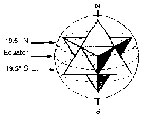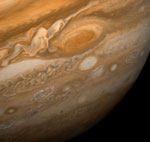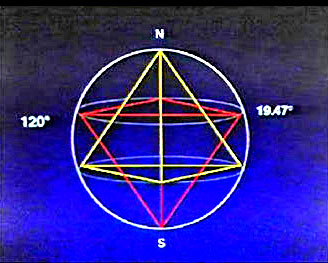
| The Planetary Grid |
| Stargates |
| Bruce Cathie's Discoveries |
| The Platonic Solids |
| The Octahedral Universe |
| DodecaIcosahedron Grid |
| The Metatronic Grid |
| Higher Chakras |
| Grid-Work |
| Conclusions |

Star
Tetrahedron inside sphere

Red
Spot on Jupiter
(Courtesy
of NASA)
Hawaii and the Star tetrahedron
In the early 1990s Richard Hoagland, a former NASA scientist, had become intrigued by what appeared, in NASA photographs, to be a number of Pyramids and a Sphinx clustered together in a region called Cydonia on the surface of Mars. As his research continued he recognized that Cydonia sits astride the 19.5-degree latitude on Mars, and that furthermore so does the ‘eye’ on Jupiter and the most active volcanoes on Earth which are on The Big Island of Hawaii. (Also on Earth the Mayan ruins in the Yucatan of Mexico sit on the 19.5 line). He was pondering these coincidences when another researcher, Drunvalo Melchizedek, who was primarily interested in sacred geometry, noticed that if you place a Star Tetrahedron (which is composed of 2 interlocking 4-sided tetrahedrons) so that it fits inside a sphere with its points touching the surface of the sphere, then if the two opposite points of the tetrahedrons are the ‘poles’ of this sphere, then the other points of the tetrahedrons touch the sphere at 19.5 degrees north and south of the ‘equator’.

The star-tetrahedron
inside a sphere, showing coordinate points
The Star Tetrahedron is significant because it is one of the shapes that energetic interdimensional vehicles, known as the ‘Merkaba’ or ‘Light-body’, manifest as. At Planet Earth’s 19.5-degree latitude we have the intersection between the light body of the planet with its surface, and since light-bodies have the ability to connect us to other dimensions, at this latitude we have an energetic predisposition for inter-dimensional experience. Hence the massive volcanoes on Mars, the eye and Moon of Jupiter, two volcanoes on Venus, a ‘dark spot’ on Neptune, dark cloud bands on Saturn and the Volcanoes of Hawaii.

Jupiter’s
red spot and Moon at 19.5 degrees latitude south
(Courtesy of NASA)
